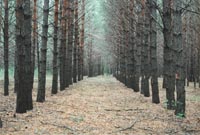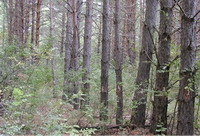УДК 630*221.02+582.475.2 (571.12/.17)
THE LESSONS OF
GRADUAL CUTTING IN DARK CONIFEROUS PINUS
SIBIRICA FORESTS OF THE WESTERN SIBERIA Download
PDF
(203 KB)
I.A. Bekh, S.A. Krivets,
V.V. Chitorkin, E.N. Pats, L.E. Voloshina
Tomsk State University,
36 Lenin
Prospekt, Tomsk, 634050, Russia
Volume
XXII,
Number 1, 2004
Abstract
Effects of two-stage cutting with
felling-bunching machines were studied in dark coniferous - Siberian stone pine
forests in West Siberia. In 1985 the fist stage of the cuttings was made in green
mossy stands (Siberian stone pine growing stock was 50%, spruce one was 20%, fir one was 20% and
birch one was 10%) on drain sand soil. Age of Siberian stone pine trees was 210
years, spruce was 160 years, fir was 160 years and birch was 110 years. Total growing stock was 295 cubic
meters per hectare. Harvesting area was divided on swaths of 18-20 m width and worked by the felling- bunching
machines. The each third swath was first cut. After the first stage of the
cutting the stand composition was not changed
but the mean degree of stocking decreased by 0.4 and growing stock by 152 cubic meters per hectare on
stratum. On the cutover birch young stands with young Siberian stone pine,
spruce and fir trees has been formed. Our
study confirmed that the felling-bunching machines were be able to use in the
dark coniferous - Siberian stone pine
forests on the drain soils. The cutting are carried out by two stage by a
combined technology. The harvesting area
is divided on swaths of 20 m width. The each third swath is first cut. In 8-10
years the remainding forest line is
cut with logway along border between swaths. The second stage of the cutting is
motor-manual felling with machine
skidding. Such technology provides sustainability of the stand after the first
stage, survival of the seedlings (65-70% of the harvesting
area) and natural growing by value trees. Siberian stone pine ; stands reforestation and formation process can be
expedite forestry methods which can develop a Siberian stone pine j forests
having a special purposes (the forests with high quality Siberian stone pine
timber and high seed productivity).
References





